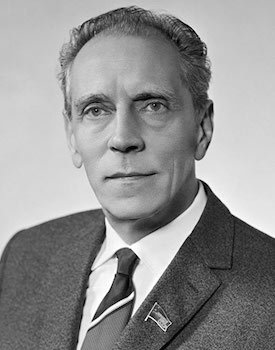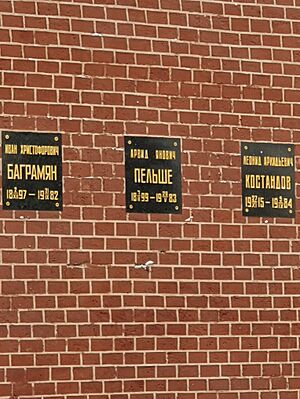Arvīds Pelše facts for kids
Quick facts for kids
Arvīds Pelše
|
|
|---|---|
|
Арвид Пельше
|
|

Pelše in 1969
|
|
| Chairman of the Party Control Committee of the Central Committee | |
| In office 8 April 1966 – 29 May 1983 |
|
| Preceded by | Nikolay Shvernik |
| Succeeded by | Mikhail Solomentsev |
| First Secretary of the Communist Party of Latvia | |
| In office 25 November 1959 – 15 April 1966 |
|
| Preceded by | Jānis Kalnbērziņš |
| Succeeded by | Augusts Voss |
| Full member of the 23rd, 24th, 25th, 26th Politburo | |
| In office 8 April 1966 – 29 May 1983 |
|
| Personal details | |
| Born | 7 February 1899 Iecava Parish, Courland Governorate, Russian Empire |
| Died | 29 May 1983 (aged 84) Moscow, Russian SFSR, Soviet Union |
| Resting place | Kremlin Wall Necropolis, Moscow |
| Nationality | Latvian |
| Political party | RSDLP (Bolsheviks) (1915–1918) CPSU (1918–1983) |
| Profession | Politician, historian |
Arvīds Pelše (Russian: А́рвид Я́нович Пе́льше, Arvid Yanovich Pelshe; February 7, 1899 – May 29, 1983) was an important Latvian Soviet politician and historian. He held high-ranking positions in the Communist Party for many years.
Contents
Early Life and Revolutionary Start
Pelše was born in 1899 into a farming family in a place called Mazie farm, near Zālīte, Iecava in Bauska District, Latvia. He was baptized in the local church soon after.
Joining the Communist Movement
When he was a worker in Riga, Pelše joined a political group called the Social-Democratic Party (Bolsheviks) of the Latvian Region in 1915. This group aimed to change society. In 1916, he even met Lenin, a very famous revolutionary leader, in Switzerland.
Working and Revolting
Between 1914 and 1918, Pelše worked in different factories. He was a milling machine operator in Riga and Vitebsk, and he worked at a steam-engine plant in Kharkov. He also worked as a punching worker in Petrograd and a loader in the port of Arkhangelsk.
He became involved in spreading revolutionary ideas. He was a delegate for a big meeting of the Russian Social Democratic Labour Party. Pelše took part in the February Revolution in 1917 and was a member of the important Petrograd Soviet. He also helped prepare for and carry out the October Revolution in 1917, which brought the Bolsheviks to power.
Early Government Roles
In 1918, Pelše joined the Cheka, which was a security organization. That same year, Lenin sent him to Latvia to help with the revolution there. In 1919, he joined the Red Army, which was the Soviet military. Later, he became a manager in the Construction Ministry of the short-lived Latvian Socialist Soviet Republic. After this government was defeated, he went back to Russia in 1919.
Rise in the Communist Party
From 1919 to 1929, Pelše worked as a teacher and political leader in the Red Army. He continued his education and graduated from a history program in Moscow in 1931. He also taught history at various institutes.
Role in Latvia
In June 1940, Pelše played a key role in Latvia joining the Soviet Union. From 1941 to 1959, he was a Secretary of the Central Committee of the Communist Party of Latvia. His job was to spread information and ideas. During World War II (1941-1945), he helped prepare people to turn Latvia into a communist state.
In 1958, he visited Denmark for a Communist Party meeting. In 1959, about 2,000 leaders and activists in the Communist Party of Latvia were removed from their jobs. This was to get rid of any ideas that were seen as too nationalistic.
Becoming First Secretary
The Soviet leaders then made Pelše the First Secretary of the Latvian Communist Party on November 25, 1959. He replaced the person who had been removed. In January 1960, Pelše quickly criticized his former colleagues for not following the "right path." From then on, the First Secretaries in Latvia were seen as very loyal to the Soviet government.
Moving to Moscow
In 1961, Pelše became a member of the powerful Central Committee in Moscow. That same year, after the first cosmonaut Yuri Gagarin returned from space, Pelše suggested changing the name of Latvia's capital city, Rīga. However, the main Soviet leaders thought this idea was too extreme.
In 1963, Pelše led a special group, sometimes called the "Pelše Commission." This group looked into the assassination of a politician named Sergei Kirov. The commission finished its work in 1967.
Pelše served as First Secretary of Latvia until April 15, 1966. At a big Party meeting in 1966, Pelše told his colleagues: "We will never allow anyone to interfere in our internal affairs but will fight against any outside interference in the affairs of other countries and peoples."
On November 7, 1975, Pelše gave a speech celebrating the 58th anniversary of the October Revolution. In his speech, Pelše said that the Soviet Union would continue to support "fighters for freedom" and "patriots" in places like Angola.
Later Years and Legacy
Pelše was rewarded for his loyal service. In 1966, he became a full member of the Politburo of the CPSU. This was one of the most powerful groups in the Soviet Union. He held this position until he died in May 1983. Pelše was also the Chairman of the Party Control Committee from 1966 to 1983. This committee was in charge of making sure party members followed the rules.
Health and Passing

Pelše's health was not good in his last years. When he did not attend the funeral of Soviet leader Leonid Brezhnev in November 1982, some people thought he had died. But a few days later, he appeared at a meeting. Another time he was absent was at a ceremony for Karl Marx in March 1983, about a month before he passed away.
He had lung cancer and heart problems. He died from a cardiac arrest on May 29, 1983. Pelše was given a state funeral, which is a very formal funeral for important people. His body was displayed at the House of Trade Unions. On June 2, his ashes were taken by a special vehicle to Red Square in Moscow. All the members of the Politburo stood on top of Lenin's Mausoleum. After speeches by Soviet leader Yuri Andropov and other officials, his ashes were placed in the Kremlin Wall Necropolis, a special burial place for Soviet leaders.
Writings and Honors
Pelše wrote several books about the history of the CPSU. He also wrote about the revolutionary movement in Latvia and the building of socialism and communism in the country.
He received many awards for his work. He was given the title of Hero of the Socialist Labor twice (in 1969 and 1979). He also received 6 Order of Lenin medals, the Order of the October Revolution, and other medals. After he died, the Rīga Polytechnic Institute was named after him.
Family Life
Pelše was married three times. He had two children from his first marriage: a daughter named Beruta (who died) and a son named Arvik (who died during World War II). He had one son from his second marriage, Tai, who was born in 1930. Tai did not stay in touch with his father after his third marriage. Pelše's third wife was Lidiya, who was the ex-wife of Stalin's secretary Alexander Poskrebyshev. From 1966 until his death, Pelše lived at 15 Spiridonovka Street in Moscow. A special plaque was placed on the building to remember him.

